Blog about successful marketing strategies in russia
Advertising on Telegram: What Works in 2025


DIGITAL MARKETING
Share this Post
After Instagram and Facebook were banned and advertising opportunities on YouTube sharply declined, Telegram became the primary channel for reaching the Russian audience. It’s no longer just a messenger, it’s a news feed, a product showcase, and an advertising platform all rolled into one app.
By 2025, Telegram reached 78.3% of all internet users in Russia, over 86 million people. On average, they spend more than two hours a day in the app, longer than on VK and nearly on par with WhatsApp. However, there is a key difference: Telegram is a public space. There’s no algorithmic feed, no hidden rules — only personal subscription choices.
Thanks to this, channels within Telegram have become a new media format, free from censorship, unpredictable reach cuts, and offering direct access to the audience.
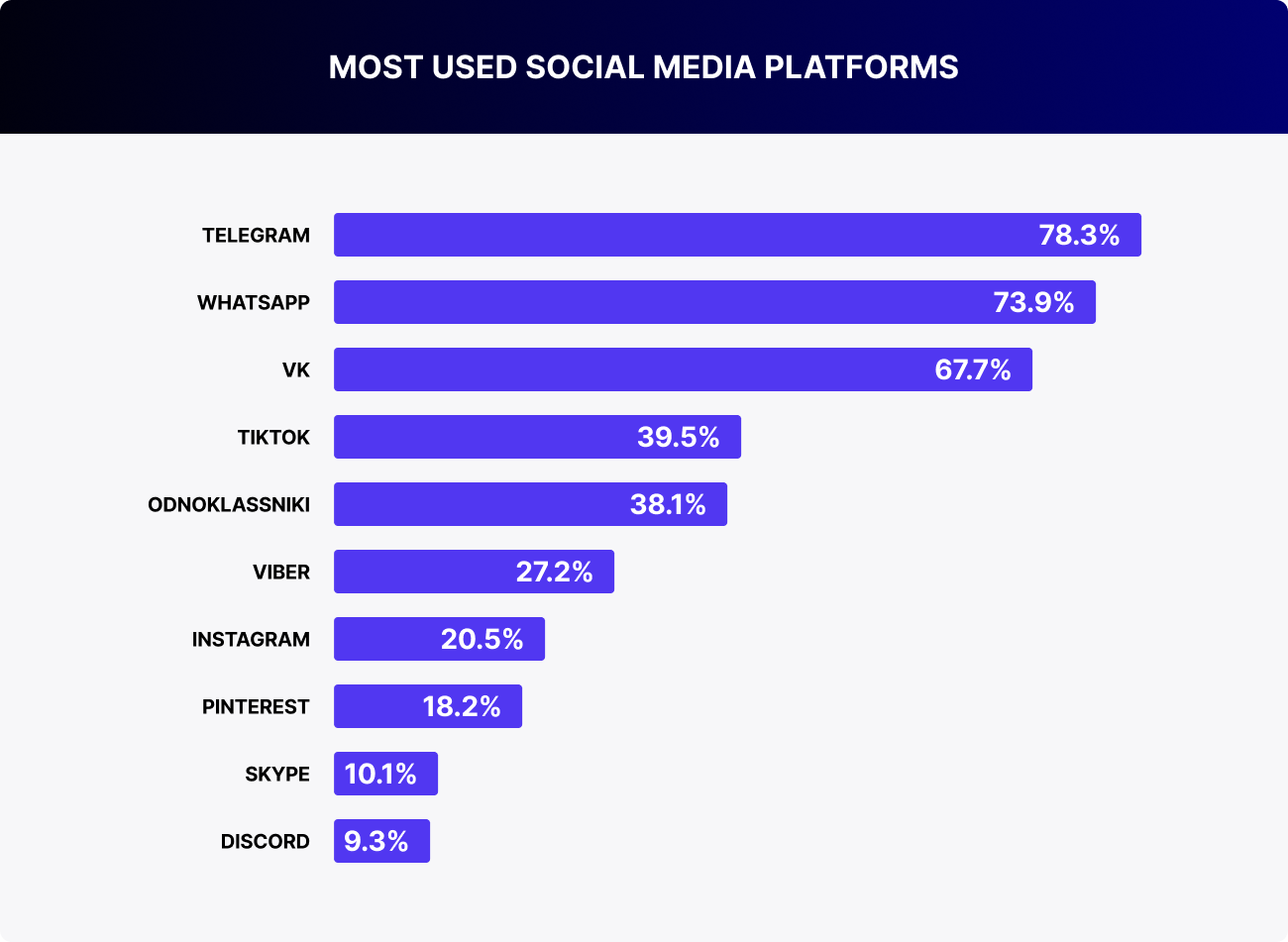
For brands, this space has introduced a completely different approach to building a presence. On Telegram, you can reach a user's feed directly, bypassing algorithms. It allows access to niche yet loyal communities, where trust in the channel owner is often stronger than in any banner ad. And above all, the messenger has become a real alternative to traditional media: faster, more affordable, and more flexible with no lengthy approvals or complicated workflows.
As many Western advertising platforms no longer operate in the Russian market, Telegram has become the main entry point. In this article, we’ll explore how advertisers are launching campaigns on the platform, from official tools to hybrid strategies that deliver results.
All Ways to Run Ads on Telegram: From Official Tools to Custom Tactics
Telegram now offers several effective ways to launch ad campaigns, each with different mechanics, pricing models, and levels of reach. While Telegram Ads might seem like an equivalent to Facebook Ads for marketers abroad, that comparison doesn’t hold up. There’s less automation, more manual setup, and context plays a far more critical role.
The first option is Telegram’s official ad platform. These ads appear in the feeds of public channels and look like regular posts, marked with either ‘Sponsored’ or ‘Advertising’. Campaigns are set up through the official dashboard, and you can manage them yourself or work via partner support. This format has a transparent CPM model and works well for brands that prioritize broad reach and full control over how their message is delivered.
The second approach involves direct placements in Telegram channels, either manually or via third-party platforms. Services like Telega.in or Epicstars offer a basic level of automation: selecting a topic, uploading copy, and distributing across multiple channels. But in practice, they only provide an interface and basic analytics. All key steps — confirming placements, approving creatives, gathering stats — are done manually. The post’s quality, visual formatting, and engagement levels depend entirely on the individual channel admin.
The most impactful placements happen through direct deals, when you contact a channel owner and publish a native post on their behalf. This method generates the highest engagement, especially in creator-led or niche-themed channels with strong audience loyalty. However, it requires time, market knowledge, and negotiation skills.
The third method is running ads through Yandex.Direct. Telegram channels are part of Yandex’s ad network, and those ads can appear inside bot interfaces or proxy resources. This tool is often used to test hypotheses or drive traffic.
As of 2025 in Russia, these formats don’t compete — they complement each other. An effective strategy combines all three approaches in a smart, balanced mix.
Let’s take a closer look at each method.
Telegram Ads: Precise but Restrained Advertising Through the Official Platform
Telegram Ads is the platform’s own built-in tool for ad placements. These ads appear in the feed between posts in popular channels and are designed to blend in: no aggressive visuals, no flashy design, nothing intrusive. Visually, it’s just a post with a small ‘Sponsored’ or ‘Advertising’ tag.
There are two common styles for Telegram Ads:
- A standard, neutral format — short, straightforward text focused purely on the offer, with little personality.

- Ads that mimic the tone of the channel — with humor, casual phrasing, or editorial-style commentary to better fit into the feed.
Thanks to this native style, the ads don’t disrupt the rhythm of Telegram content and are perceived more gently. Still, despite its tech-forward nature, this tool comes with certain limitations. We’ll cover those in more detail shortly.
There are two ways to launch a campaign. The first is self-service through ads.telegram.org, with a minimum budget of €500. Basic targeting options are available: interests, region, language, device type. The second route is through Telegram’s official partners, with a starting budget of €3,000. This path offers more in-depth analytics, advanced targeting, tech support, and strategic consulting.
There are three ad formats: text with a button, media with a caption, and autoplay video with a built-in call to action. All ads run on a CPM model. In news-related placements, rates start around €0.50, while commercial categories can easily reach €1.50 and up.
Available targeting parameters include language, location, user interests (based on channel subscriptions), device type, and even showing ads to followers of competing channels. However, what you can’t do is choose specific channels for placements. Manual channel selection isn’t an option. This is the core limitation of Telegram Ads. You’re launching blind, with no ability to handpick where your ad will appear. For brand managers who are used to having visual and contextual control, this can be a drawback.
Telegram Ads Isn’t Perfect: What Frustrates Advertisers
Despite its transparency and user-friendly setup, Telegram Ads doesn’t always live up to brand expectations. This is especially noticeable in low-engagement niches, like B2B or when promoting complex products. In such cases, CTR tends to fall short, and direct sales messages often get lost among more engaging, organic posts in the feed.
Another pain point is the lack of storytelling potential. The formats are too minimalistic. You can’t build a narrative, roll out a series of posts, or guide the audience toward a purchase over time. The post has to grab attention immediately, and if it doesn’t stand out visually and only offers a button and a single paragraph, any chance of meaningful storytelling falls apart.

There are also thematic restrictions. Telegram doesn’t allow ads related to cryptocurrency, supplements, medicine, political topics, and other sensitive areas that could trigger legal issues in Russia. This automatically narrows the range of advertisers who can use the platform directly.
That’s why Telegram Ads is often treated as an entry point — a way to generate reach, brand awareness, and first-touch engagement. From there, advertisers usually layer in native placements and direct integrations. The goal isn’t just to make a splash, but to earn trust and stay present in the audience’s mind over time.
TMA Ads: Advertising Inside Telegram Mini Apps
Beyond the familiar channel feed ads, Telegram offers another, less obvious but highly compelling tool — TMA Ads. These are ads embedded directly into mini-apps: bots, storefronts, subscription services, crypto wallets, and other Telegram Mini Apps. Everything happens within the messenger itself. The user sees the ad, taps it, and immediately takes action: placing an order, signing up, or accessing a service. No extra steps, no redirects.
For instance, through the Wanttopay bot, Russian users can issue international virtual cards directly within Telegram.
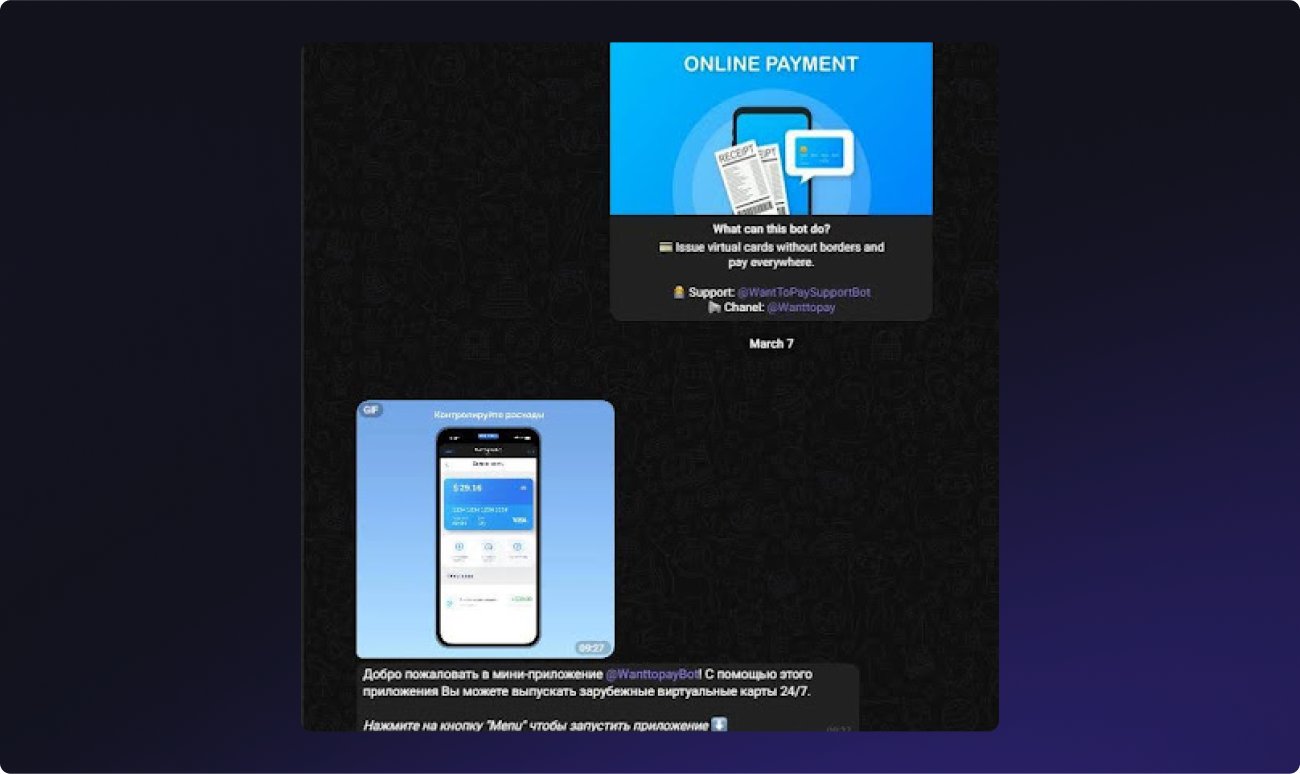
This is exactly where TMA Ads come into play. The average CPM here is higher, starting at $1.80, but the engagement can be impressive. In Russia, the average CTR is around 1%; in some other countries, it climbs as high as 5%. The core audience is Android users (around 84%), though the format does work on iOS as well, albeit at a smaller scale.
This ad format performs especially well in e-commerce, subscription models, and micro-sales, wherever action matters more than just awareness. Campaigns are set up through a separate ad platform and, more often, with the help of official partners, since the process requires precise configuration and a clear understanding of how Telegram Mini Apps function.
TMA Ads are most powerful when combined with Telegram Ads. The first captures attention and builds reach, while the second drives users to act. It’s like browsing a display window and then immediately checking out, all without leaving the store. One seamless interface, no distractions, no extra screens.
Telegram Ads vs. TMA Ads: Different Tools for Different Goals
Telegram Ads and TMA Ads are both official formats, built into Telegram’s native infrastructure, but they function differently and serve entirely distinct purposes.
| Parameter | Telegram Ads | TMA Ads (in Mini-Apps) |
|---|---|---|
| Placement Format | In the channel feed (inserted between posts) | Inside mini-apps (bots, storefronts, services) |
| Objective | Mass reach, brand awareness | Engagement, conversions, user actions |
| User Journey | Redirect to a channel or external link | Action within Telegram without leaving the app |
| Best For | News triggers, brand launches, announcements | E-commerce, ordering, registration, lead generation, payments |
| CTR in Russia | ~0.3–0.7% on average | ~1% (higher engagement) |
| CPM | from €0.5–1 | from $1.8 |
| Setup Flexibility | High audience targeting, but no channel selection | Deep integration into the mini-app scenario |
Telegram Ads appear within channel feeds — between posts, in a format that closely mimics regular content. They’re ideal for campaigns where broad reach matters most: brand launches, announcements, breaking news. In essence, it’s like digital out-of-home advertising, but inside a messenger. The user sees the message, clicks, and is redirected to a channel or website. The goal here is awareness and the initial touchpoint.
TMA Ads, on the other hand, are a completely different story. These are ads built directly into Telegram Mini Apps — bots, storefronts, marketplaces, and services. The user never leaves the interface. They see the ad, click, and instantly take action: sign up, register, place an order. This format is tailored for e-commerce and quick conversions. Engagement is notably higher. In Russia, the average CTR is around 1%, compared to 0.3–0.7% for Telegram Ads. Placement costs for TMA Ads start at $1.80 per thousand impressions, but so does the direct impact.
Telegram Ads offer flexible audience targeting by interests, regions, and device types. However, you can’t choose specific channels for your ad to appear in — that decision stays with Telegram. With TMA Ads, it’s the opposite: you control the entire user flow, but it requires precise setup through partners and full integration into the mini-app itself.
Ideally, these formats work best as a duo. Telegram Ads generate reach — TMA Ads drive action. One is the storefront, the other is the checkout. And the clearer we are about which objective we’re solving, the better the overall results will be.
Advertising on Telegram via Yandex.Direct
In July 2023, Yandex officially launched ad placements in Telegram channels. Initially, the format was in testing and only accessible through the Expert Mode as part of the Unified Performance Campaign.
By March 2025, Yandex introduced a new model — advertising through the Yandex Advertising Network (YAN). Under this model, advertisers can select specific channels and manage CPM bids. Currently, this feature is in closed beta, and the main tool remains automatic placements via YAN.
You can find a detailed breakdown of Telegram advertising via Yandex.Direct in this guide.
How Telegram Ads Work Through Yandex.Direct
Ads appear in Telegram channels that are connected to YAN. These posts look like regular content: an image, some text, and a button leading to a website or bot. The required ‘Advertising’ label from Yandex and a link to the ‘About the Advertiser’ page are added automatically.
Campaigns are launched through Yandex.Direct interface, so there’s no need to access the Telegram Ads dashboard. Billing is CPC-based, meaning you only pay for clicks. Each sponsored post remains in the channel for a maximum of 48 hours before being automatically removed.
During setup, you can select channel categories such as auto, real estate, or finance as well as audience location and interest segments. The system then automatically matches ads to channels based on your chosen parameters.
Yandex.Direct does not track subscriber counts for advertised channels. To monitor subscriptions, the advertiser must create a custom Telegram invite link and embed it in the ad. Subscriptions are counted manually, and the cost per subscriber is calculated by dividing ad spend by the number of acquired followers.
There are a few placement nuances. It can take a few days for a campaign to start after launch. No new posts will be published within the final 48 hours of the campaign, and each ad is automatically removed 48 hours after being posted, even if the campaign is still active.
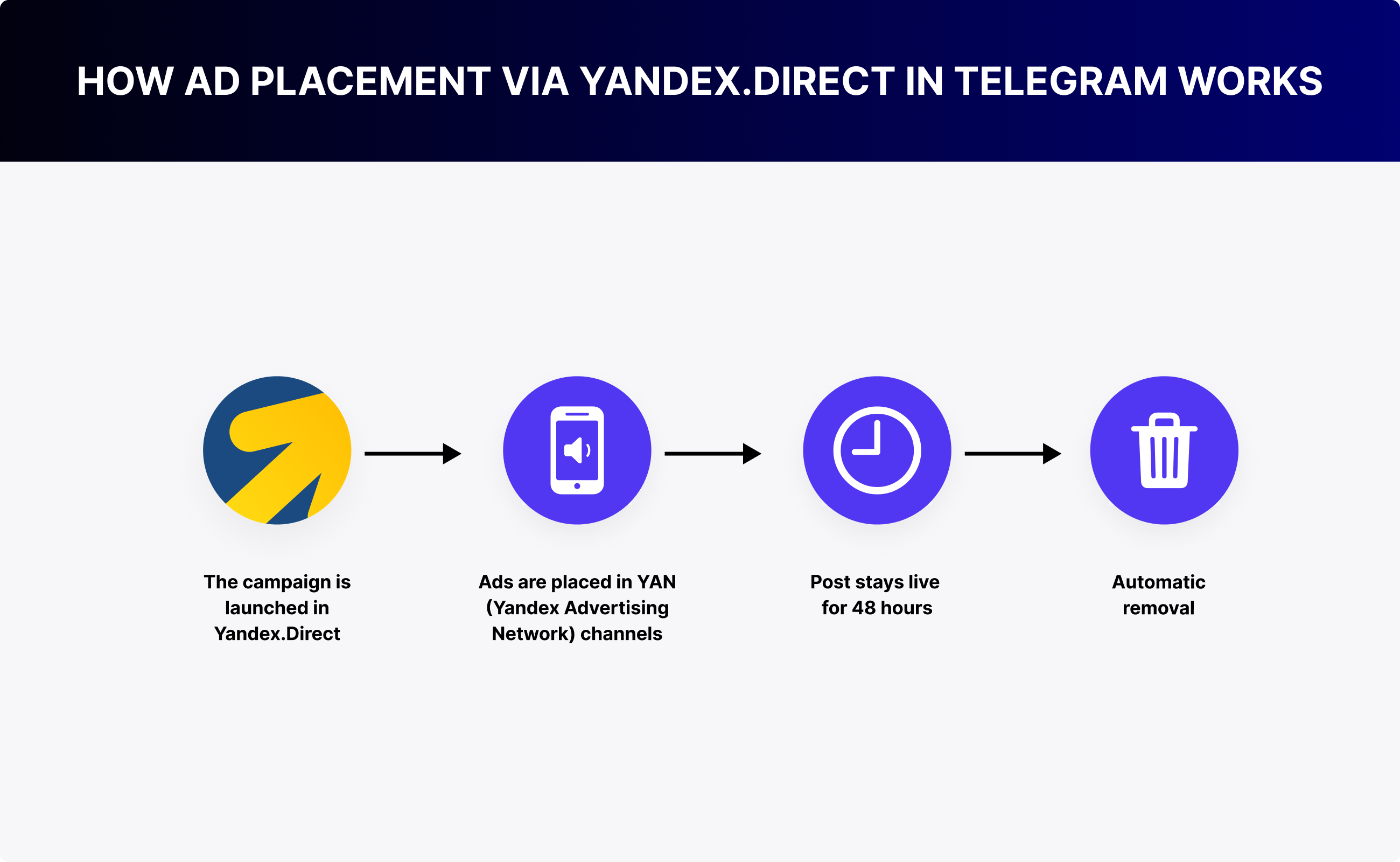
Brand Safety in Yandex.Direct for Telegram
Before any ad is placed, Yandex carefully reviews the channels, evaluating not only current content but also past publications. If any inappropriate or undesirable material is found, ads are not placed in that channel. If issues arise after the ad has gone live, the post is automatically removed.
For advertisers spending over ₽250,000 per month (excluding VAT), an enhanced Brand Safety program is available. This provides stricter quality control throughout the campaign’s duration.
Advertising on Telegram via Yandex.Direct offers brands a convenient way to reach Russian audiences without the need to access Telegram Ads. It’s a practical tool for achieving fast reach, driving traffic, and testing new audience connections.
If full control over channel selection and content presentation is a priority, it’s worth keeping an eye on the development of Reach Ads through YAN. It’s currently in beta but already opening up new opportunities for brands.
Placement through Yandex is a separate mechanism, not directly connected to Telegram Ads. To better understand the differences between Telegram advertising via Yandex.Direct and official placements through Telegram Ads, let’s compare their key features:
| Parameter | Yandex.Direct in Telegram | Telegram Ads |
|---|---|---|
| Where it is configured | Yandex.Direct | Telegram Ads Manager |
| Payment model | CPC (cost per click) | CPM (cost per thousand impressions) |
| Channel selection | Automatic or beta-testing option | Automatic (no manual selection) |
| Labeling | “Advertisement” by Yandex | “Sponsored” or “Advertisement” by Telegram |
| Subscription tracking | Only manually via invite links | No built-in tracking |
Manual Integrations: Native Ads in the Voice of the Channel Admin
This is the most engaging ad format available on Telegram, especially when it appears in a personal, creator-led space where every word feels like a direct message to the reader. In this context, a branded post becomes part of an ongoing conversation, an extension of trust.
Why does this format outperform all others? It’s simple: the content is either written or adapted by the creators themselves. It’s not a drop-in insert, not a press release, not a CTA block. It’s their voice, their tone, their delivery. And the audience doesn’t perceive it as advertising. It feels like a recommendation from someone they already trust. No labels, no loud buttons, no aggressive prompts — just an organic story that blends seamlessly into the feed. That’s why this format is irreplaceable when you need to explain a complex product, tell a brand story, or build visual intrigue around a new launch.
But manual integration also comes with trade-offs. It’s a live format, which means it depends entirely on people. Admins have their own schedules, and posts can get delayed, rescheduled, or canceled altogether. The human factor is unavoidable. Even a pre-approved post can end up looking off as someone might change the title, drop in the wrong screenshot, or format it inconsistently. That risk needs to be accounted for.
Also, manual advertising cannot be scaled with a click. Each placement is a separate deal. Want twenty integrations? That means twenty negotiations, contracts, payments — all handled manually, with no dashboard or unified system. This format isn’t built for volume. It’s a precision tool. It’s used where impact matters more than reach, where the goal isn’t just to be seen, but to connect, resonate, and stick in the audience’s mind.
It works especially well in beauty, lifestyle, and brand launch campaigns — any space where advertising needs to sound like it’s coming from someone, not aimed at everyone.
Seeding via Platforms: Mass Reach, Fast and Affordable
If Telegram Ads is automated advertising on the platform’s terms, and manual integration is nearly a one-on-one partnership, then seeding through platforms like Telega.in or Epicstars offers something in between. Here, you can book dozens of placements at once — no back-and-forth with admins, no waiting, no extra steps. Just set your parameters, upload the copy, define your budget, and the system handles the distribution across channels automatically.
This approach is ideal when the goal is reach. It’s fast, scalable, and cost-efficient. It works especially well for product launches, flash sales, or major announcements — situations where speed matters more than message nuance. A campaign can be built in just a few clicks. The platform shows a list of relevant channels based on topic, subscriber count, CPM, and engagement. Channel admins receive the request and decide whether to accept it. Everything else runs on autopilot.
The delivery is usually just as automated. Posts go live as straightforward ads, with little to no adaptation or personal touch. Sometimes this works. Other times, the message gets lost in the feed, especially in channels saturated with back-to-back ads. There are rare cases where the admin is genuinely interested and tailors the content, but those are exceptions, not the rule.
Platforms offer filtering options: you can narrow by topic, set minimum reach, exclude inactive channels, and even target specific geographies. But brand safety is basic at best. A channel might appear active, but the actual context could be far from appropriate. Instead of a clean placement, your brand could end up next to toxic, clickbait, or off-brand content.
That’s why this method works best for testing, top-of-funnel campaigns, or driving drift traffic. It’s well-suited for simple offers with low entry barriers, where volume matters more than depth. This isn’t about trust. Or storytelling. It’s about numbers. Sometimes, it’s the only way to gather data quickly or warm up a cold market. But if a brand has a voice, a face, and a story, skipping manual customization won’t cut it.
Telegram also allows for direct collaboration with channel admins, bypassing third-party platforms. This is especially common with official media channels, which typically prefer formal agreements directly with brands or their agencies.
What to Choose: Telegram Ads, Yandex.Direct, or Manual Placements
Each of the three Telegram ad formats is a distinct tool, with specific strengths and limitations. The table below compares them to help you determine which approach fits your objectives best.
| Criterion | Telegram Ads | Seeding Platforms | Manual Integration |
|---|---|---|---|
| Entry Cost | from €500 (Self) | from ₽1000 per placement | from ₽5000–15 000 per channel |
| Setup and Launch | via Telegram Ads Manager | automatic | manual, through direct agreements |
| Audience Quality | depends on the targeting parameters | unstable, requires filtering | depends on the channel and engagement |
| Format Flexibility | low (strict format requirements) | medium (can attach photo/text) | high (adapted to channel’s style) |
| Engagement | medium | low | high |
| Scalability | high | high | low |
| Brand Safety | high (Telegram moderation) | medium (depends on filters) | low (based on trust) |
| Suitable for Sensitive Topics | limited by platform rules | with reservations | yes, if properly presented |
The core takeaway is simple — and important:
Telegram Ads should be your go-to when you need scale and a clear, structured setup. It’s a format built for reach, awareness, and testing, when the priority is getting on the radar of as many people as possible.
Platform-based seeding is the right fit when you're aiming for dozens of placements. It’s a fast and cost-effective way to meet volume demands, best used when speed and reach outweigh depth of engagement.
Manual integrations, on the other hand, are in a league of their own. This is about brand image, storytelling, and emotional connection — the kind of ‘ad that doesn’t feel like an ad’. It’s not just about what you say, but how you show up in the feed, not as a banner, but as a person.
When and How to Combine Approaches
No single Telegram ad format can cover all marketing objectives on its own. Real results come when formats are used together, reinforcing one another. This is especially true in complex niches, where success isn’t just about clicks, but about trust, awareness, and sustained attention.
One effective scenario is pairing Telegram Ads with TMA Ads. First, the advertiser captures audience attention through feed posts in popular channels. Then, anyone who engages is immediately funneled into a mini-app to register, place an order, or complete a purchase. This combination is ideal for e-commerce and digital services, where it’s not enough to inform — you also need to drive conversion. The key is a clear message and a sharp CTA.
Another strategy is combining manual integrations with a branded channel. A post written in the admin’s voice feels like a personal recommendation, and once the user clicks through, they subscribe. That subscription isn’t just a metric; it’s a commitment. This tactic works especially well in beauty, education, finance, and wellness — anywhere a long-term relationship is more important than a one-time sale.
There’s also a third approach: mass seeding backed by influencers. It’s a bet on reach. Seeding delivers scale, while content creators bring emotion, personality, and trust. The key is balance. If the messaging isn’t aligned, you risk creating noise instead of momentum. But when everything is properly coordinated, it creates the effect of the brand being everywhere at once.
Here’s what a real working Telegram strategy looks like in 2025:
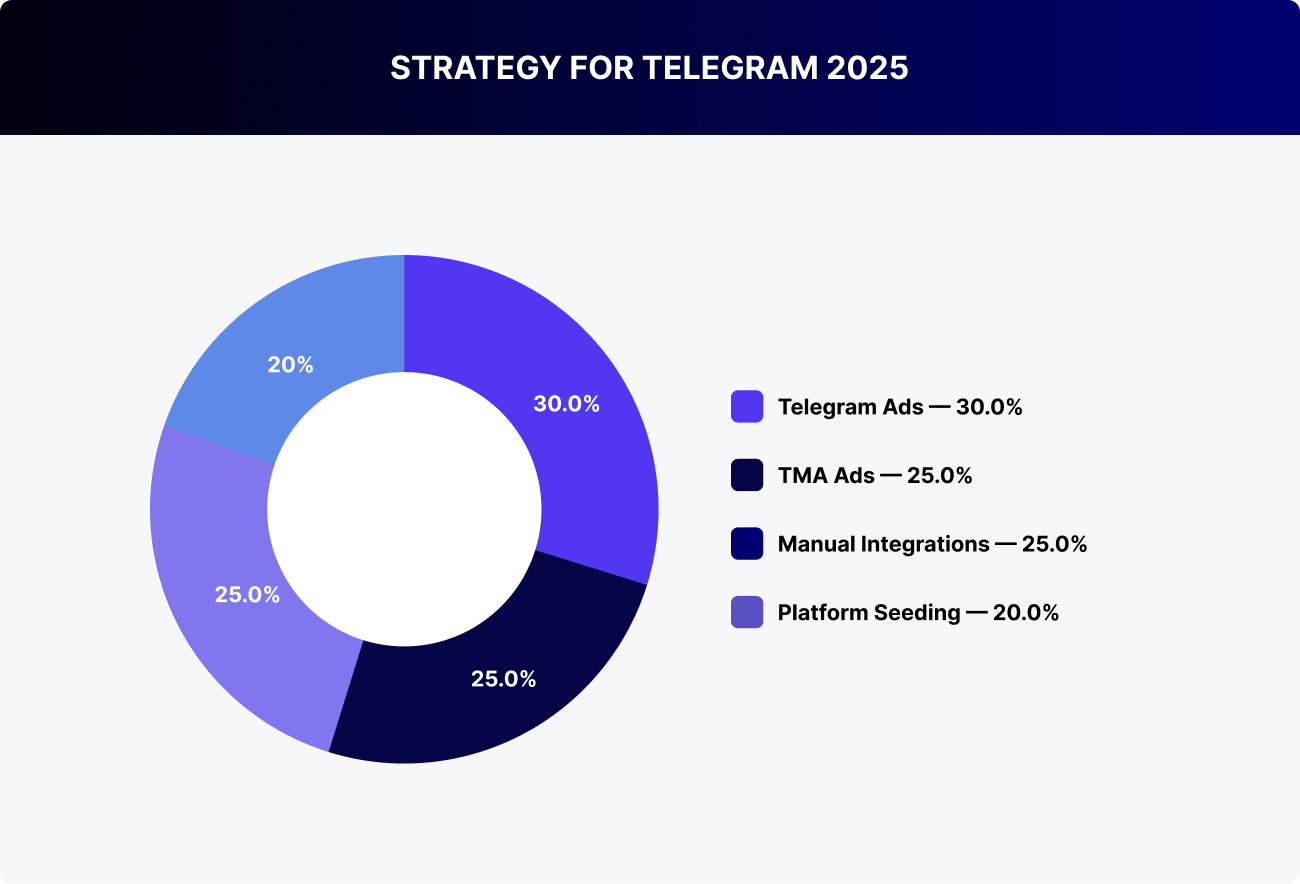
Telegram Ads drive reach — they’re the entry point. TMA Ads amplify response, turning attention into action. Manual integrations build engagement and trust, especially in niche segments. Seeding remains a solid launch tool for bursts of visibility, though its relative weight is fading. The formula 30/25/25/20 shaping up today is a reflection of real market demand. Brands are increasingly blending reach, engagement, and action into a single system.
In 2025, success doesn’t belong to those who just throw money at ads. It belongs to those who understand how Telegram works in Russian. To those who don’t just post, but speak, not at the audience, but with them.
Let’s summarize
By 2025, Telegram has become the central digital ecosystem in Russia. It’s where people read the news, shop, and engage with brands, all within a single, uninterrupted flow.
User engagement continues to grow thanks to mini-apps. With TMA Ads, brands now drive real actions, not just clicks. Formats are getting shorter, reactions faster. For many, Telegram is no longer just a messenger. It’s replacing websites, storefronts, and landing pages.
The political climate has only heightened the importance of independent platforms. With Western services restricted, Telegram remains one of the few tools that enables direct communication with Russian audiences, without intermediaries and external algorithmic control.
The user has changed, too. Behavior is shifting toward private, controlled spaces. As people move away from traditional platforms, Telegram has taken over as the primary channel for audience interaction.
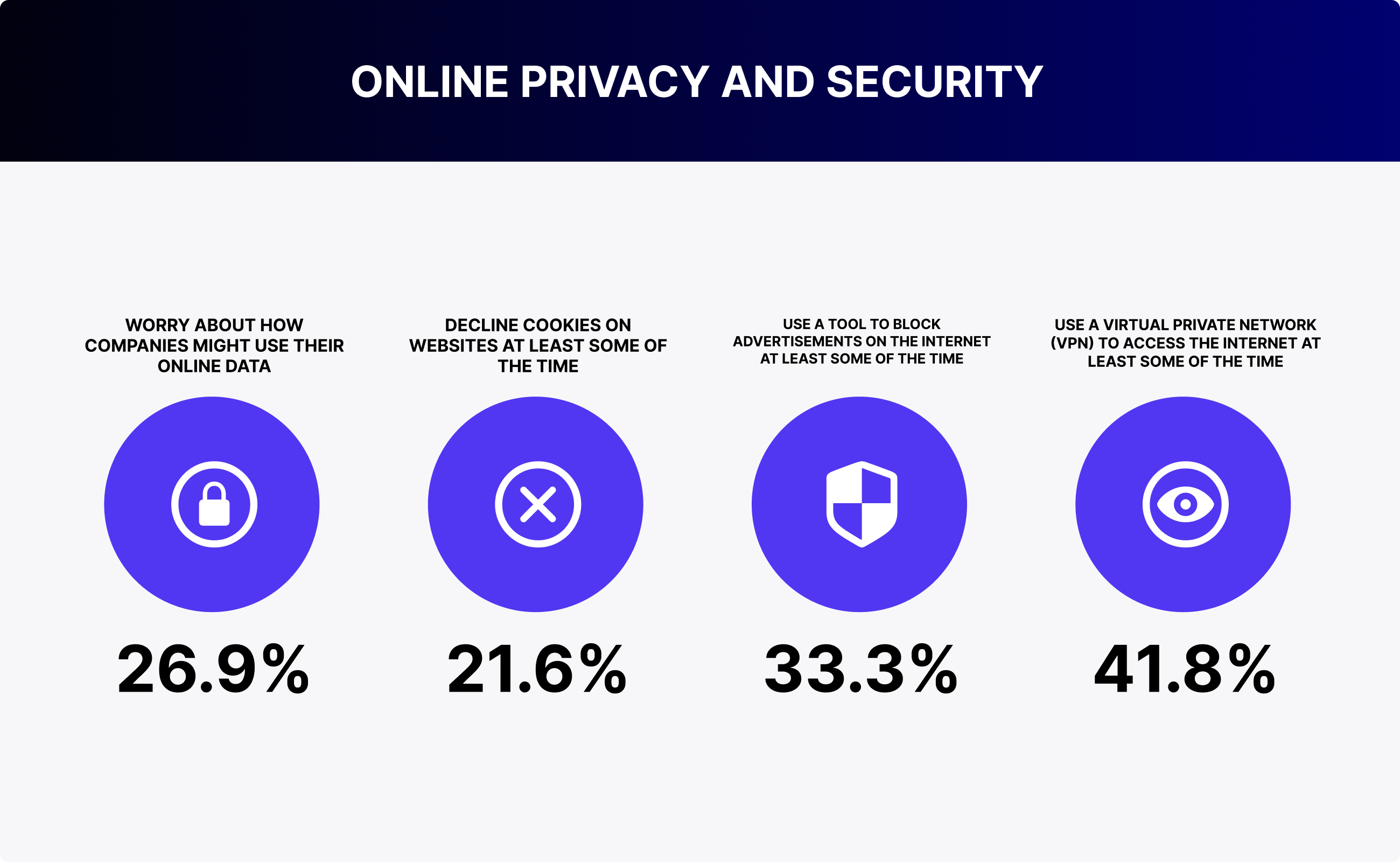
In reality, Telegram is no longer just an option. It’s a requirement for anyone planning to operate in the Russian market. It’s not just one more channel in the media mix, but the core environment for digital presence.
Brands that understand this shift are seeing results. Those still relying on outdated playbooks are losing both money and trust.
If you're ready to build the right Telegram strategy and avoid getting lost in this new ecosystem, get in touch. You’ll find the contact form below.
And if you want to go deeper into how marketing works in Russia today, subscribe to our blog.
Join 2,000+
of your Peers!
You will be the first to know about Russian marketing insights, news and updates from our agency. Stay tuned!
Get our latest articles delivered to your email inbox and get our exclusive White Paper
"Digital Marketing in Russia. Finding your customers on the internet"
for FREE!
Russian Digital Market Overview
Strategic Insights into Russian Digital Marketing Landscape

Ready to partner with the specialists in Russian marketing and advertising?
About the Author
Digital Strategist. Head of one of the project groups at RMAA. Maria started her journey in digital marketing in 2009.
Join 2,000+ of your Peers!
Get our latest articles delivered to your email inbox and get our exclusive White Paper "Digital Marketing in Russia. Finding your customers on the internet" for FREE!
You will be the first to know about Russian marketing insights,
news and updates from our agency.
Stay tuned!
We're updating our website's design step by step, so some pages may look different. Thank you for your understanding.
Got it














